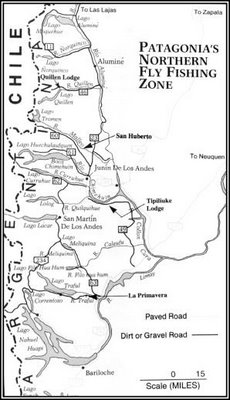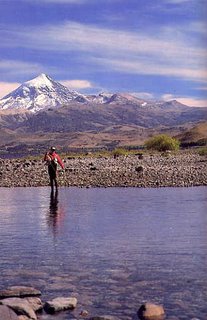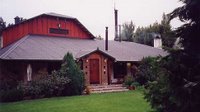The Region and Rivers
 Patagonia's Northern Fishing Zone lies on the foothills of the Andes in the Province of Neuquen, a good two hour flight time from Buenos Aires. The small airport at Chapelco serves both San Martín de los Andes, well known as a top skiing resort in the winter, and the small town of Junín de los Andes which claims to be the Trout Capital of Argentina.
Patagonia's Northern Fishing Zone lies on the foothills of the Andes in the Province of Neuquen, a good two hour flight time from Buenos Aires. The small airport at Chapelco serves both San Martín de los Andes, well known as a top skiing resort in the winter, and the small town of Junín de los Andes which claims to be the Trout Capital of Argentina.The geography is open grasslands in great expansive valleys surrounded by rugged mountains. The Cordillera de los Andes lies to the West along the Chilean and Argentinean divide. This is the region that made Argentine trout fishing famous. You will be fishing the most important rivers in the Zone: Río Malleo, Río Aluminé and Río Chimehuin.
Río Malleo
 Like most Argentine trout streams, the Malleo originates in a lake high in the Andean Mountains. Nestled in the folds of dormant Volcán Junín (12390 feet) and surrounded by ancient pine forests, Lake Tromen spills its waters to form the Malleo which then flows east for 50 miles to join the Río Aluminé. Beginning in a densely wooded canyon within the Lanín National Park, it meanders through a beautiful valley populated with araucaras, willows and poplars. Estancia San Huberto dominates the upper reaches of the Malleo and provides an outstanding Hostería that can accommodate 16 persons in pampered surroundings.
Like most Argentine trout streams, the Malleo originates in a lake high in the Andean Mountains. Nestled in the folds of dormant Volcán Junín (12390 feet) and surrounded by ancient pine forests, Lake Tromen spills its waters to form the Malleo which then flows east for 50 miles to join the Río Aluminé. Beginning in a densely wooded canyon within the Lanín National Park, it meanders through a beautiful valley populated with araucaras, willows and poplars. Estancia San Huberto dominates the upper reaches of the Malleo and provides an outstanding Hostería that can accommodate 16 persons in pampered surroundings.Originally a hunting lodge built by the Olsen family some 18 years ago it now caters exclusively to the fly fisherman, providing catch-and-release only waters. Weedless hooks are a kindness to Malleo trout and appreciated by Carlos and Carmen Olsen who care a lot about the quality of the fishing.
 The river contains both rainbows and browns. It is easily wadeable for most of its course with pebbled bottoms and sandy shoals. The stretch from the first fishable pools near the area of Tres Picos, through the Yellow Bridge, the Canyon and the willows down to the Lodge offers some of the best and most scenic trout waters in the world. From the Hostería down to the bridge on Ruta 23, running north from Junín de los Andes to the town of Aluminé, the river runs through areas easily accessible from the road. Below the bridge and down to the Rio Aluminé, the Malleo passes, on its north side, through a Mapuche Indian Reservation and some impressive scarped peaks with hexagonal basalt monoliths, which reach heights populated by eagles and an occasional Condor de los Andes. This section is more heavily fished than the rest but provides excellent action from smaller trout. There is no better stretch on earth to place a beginner fisherman. The Malleo is without doubt my favorite trout stream.
The river contains both rainbows and browns. It is easily wadeable for most of its course with pebbled bottoms and sandy shoals. The stretch from the first fishable pools near the area of Tres Picos, through the Yellow Bridge, the Canyon and the willows down to the Lodge offers some of the best and most scenic trout waters in the world. From the Hostería down to the bridge on Ruta 23, running north from Junín de los Andes to the town of Aluminé, the river runs through areas easily accessible from the road. Below the bridge and down to the Rio Aluminé, the Malleo passes, on its north side, through a Mapuche Indian Reservation and some impressive scarped peaks with hexagonal basalt monoliths, which reach heights populated by eagles and an occasional Condor de los Andes. This section is more heavily fished than the rest but provides excellent action from smaller trout. There is no better stretch on earth to place a beginner fisherman. The Malleo is without doubt my favorite trout stream.Río Chimehuin

The legendary Chimehuin begins its life at the historic Boca del Chimehuin in the Eastern tip of Lake Huechulaufquen, near the Volcán Lanín. The Boca is probably the most famous spot in the lore of trout fishing. Many famous anglers have cast their flies into the gin-clear run that marks the beginning of this river. Many tales and record fish have come out of this truly beautiful spot. The grandfather of Argentine trout fishing, Bebe Anchorena took the record brown in 1961 weighing an incredible twenty four pounds. After running through a narrow gorge known as the Devil's Throat, the river flows through a wide-open valley and divides into several small branches which rejoin just before entering the town of Junín de los Andes. A one restaurant, one gas station town, Junín has a charm of its own. Here, near the river's edge and not four blocks from the town's square, sits the Hostería Chimehuin. Rich in history and fishing tradition, this little old picturesque inn was the meeting place of countless of fishermen through the years. The walls of the tiny dining room are covered with the photographic evidence of the region's legendary fame in trout fishing circles. Brook, Wulff, Schwiebert, Flick, Anchorena and many more will smile at you from behind the fish that did not get away. Below the town the river is strong and difficult to wade except at the very end of the season in years of low water. The crystal clear waters and large clean rocks make it difficult wading for most of its run down to the Aluminé. Chimehuin fishing can be
 frustrating and exhilarating on the same day. Large browns make their home in the lower stretches, which are reachable only after lengthy rides or walks through the large estancias that hold the properties on both sides of the river. The river itself is breathtaking as it shows the varied colors of the rocky bottom and the rich riparian vegetation along the banks. Flocks of black-necked swans migrating from Antarctica, the largest hares you ever imagined and colorful torrent ducks accompany you along the way.
frustrating and exhilarating on the same day. Large browns make their home in the lower stretches, which are reachable only after lengthy rides or walks through the large estancias that hold the properties on both sides of the river. The river itself is breathtaking as it shows the varied colors of the rocky bottom and the rich riparian vegetation along the banks. Flocks of black-necked swans migrating from Antarctica, the largest hares you ever imagined and colorful torrent ducks accompany you along the way.Río Aluminé
 Much bigger than the Malleo, the Aluminé flows south out of a glacial lake of the same name. Its beauty touches more than 100 miles of countryside. It loses its identity at the confluence of the Río Chimehuin becoming the Collon-Cura, flowing gently through a short wide valley to die at the Alicura Reservoir. This vast lake, formed by a recently built dam will eventually fill to a level that will put the Collon-Cura as well as parts of the legendary Chimehuin and Caleufú in the history books as yet another unique trout habitat sacrificed to progress. It is the biggest river in the Northern Zone, receiving as affluents the Quillén, Ñorquinco, Malleo and Chimehuin, and containing a good population of Rainbows and Browns. It is customary to float down the river, stopping to fish the better runs and covering much of its fishable waters. Open stretches and exposed wide runs make for long casts in usually windy conditions. Heavier lines are a must.
Much bigger than the Malleo, the Aluminé flows south out of a glacial lake of the same name. Its beauty touches more than 100 miles of countryside. It loses its identity at the confluence of the Río Chimehuin becoming the Collon-Cura, flowing gently through a short wide valley to die at the Alicura Reservoir. This vast lake, formed by a recently built dam will eventually fill to a level that will put the Collon-Cura as well as parts of the legendary Chimehuin and Caleufú in the history books as yet another unique trout habitat sacrificed to progress. It is the biggest river in the Northern Zone, receiving as affluents the Quillén, Ñorquinco, Malleo and Chimehuin, and containing a good population of Rainbows and Browns. It is customary to float down the river, stopping to fish the better runs and covering much of its fishable waters. Open stretches and exposed wide runs make for long casts in usually windy conditions. Heavier lines are a must.

0 Comments:
Post a Comment
<< Home